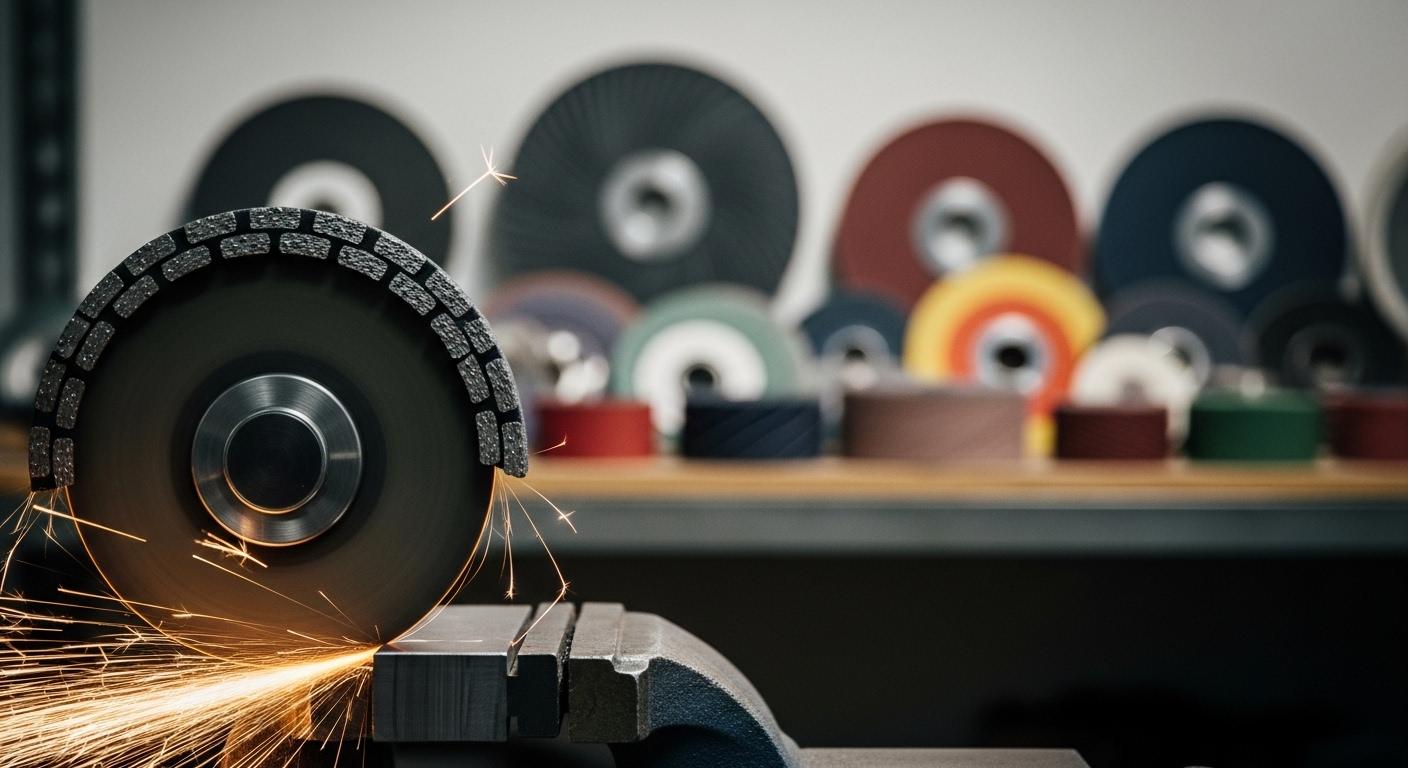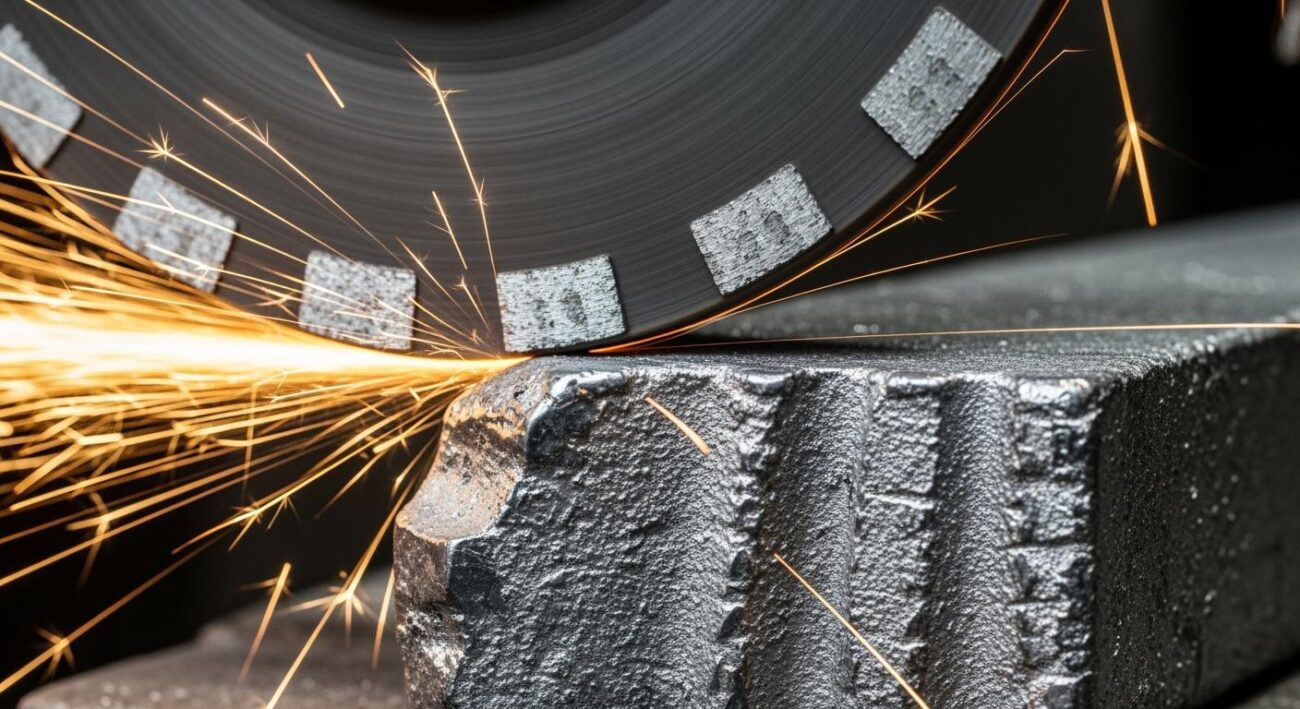Choosing the right abrasives is the most critical step for high-performance grinding. This guide gives you four steps to select the perfect brazed bond grinding wheel for your application. The right wheels help you improve productivity and efficiency. Better performance in your grinding operations brings real results.
Key Takeaways
- Match the abrasive type to your material. Use diamond wheels for non-ferrous materials like glass. Use CBN wheels for steel and other iron-based metals.
- Choose the right grit size. Coarse grit removes material fast. Fine grit gives a smooth finish. Medium grit balances both.
- Select the correct wheel shape and size. The shape must fit your grinding task. The size must fit your machine safely.
- Confirm operating settings. Use coolant to keep the wheel cool and clean. Do not spin the wheel faster than its safe speed.
Step 1: Select the Right Brazed Bond Grinding Wheel
Your first and most important decision is matching the abrasive to your workpiece material. Brazed bond grinding wheels use superhard abrasives to deliver exceptional performance. The two primary abrasives are Diamond and Cubic Boron Nitride (CBN). Choosing the correct one ensures your grinding process is efficient and effective.
Choosing the Right Brazed Diamond Grinding Wheel
You should select the right brazed diamond grinding wheel when working with non-ferrous materials. Diamond is the hardest known material, making it perfect for grinding tough substances that do not contain iron. The strong brazed bond on these wheels securely holds the diamond abrasives, providing a long service life. Using the right brazed diamond grinding wheel gives you clean cuts and excellent finishes.
Tip: A brazed diamond grinding wheel is your best choice for materials like tungsten carbide, ceramics, glass, and stone. The powerful bond ensures the abrasives stay put during tough grinding jobs.
Selecting CBN for Ferrous Metals
You need CBN abrasives when your workpiece is a ferrous metal. CBN is the second-hardest material and has superior thermal stability, making it ideal for grinding hardened steels. These grinding wheels excel where diamond fails.
Common materials for CBN grinding wheels include:
Why Diamond Fails on Steel
You might wonder why you cannot use diamond wheels on steel. At the high temperatures generated during grinding (above 700°C), the carbon in a diamond abrasive reacts with the iron in steel. This chemical reaction causes the diamond to break down quickly, ruining the wheel.
| Abrasive Type | Thermal Stability | Chemical Reaction with Steel |
|---|---|---|
| Diamond | Degrades above 700°C | Reacts with iron |
| CBN | Stable up to 1200°C | Chemically inert |
CBN wheels do not have this problem. They remain stable at temperatures up to 1200°C and do not react with iron. This makes CBN the only correct choice for high-performance grinding on ferrous metals. At Aimgrind, we use our expertise to design custom formulas for all types of materials, ensuring your grinding wheels are perfectly matched to your needs.
Step 2: Pick Grit Size for Your Application

After you select the right abrasive, your next step is to choose the correct grit size. Grit size refers to the size of the individual abrasive particles on the wheel. You will see numbers that follow standards like ANSI (American) or FEPA (European). A lower number means larger, coarser abrasives, while a higher number indicates smaller, finer abrasives. The right choice depends on your goal, whether it is rapid material removal or a flawless surface finish.
Coarse Grit for High Material Removal
You should choose coarse grit wheels for aggressive grinding and fast stock removal. These wheels use large abrasives (typically 30-60 grit) to cut through material quickly. They are perfect for jobs where speed is more important than the final finish.
Note: Coarse grit wheels will leave a rougher surface. They are best for initial grinding steps before moving to finer wheels for finishing.
Medium Grit for General Purpose Use
Medium grit wheels offer a great balance between material removal speed and surface finish. With abrasives in the 70-120 grit range, these wheels are versatile for many tasks. You can use them for moderate stock removal and to clean up imperfections. These grinding wheels are an excellent choice for general-purpose applications where you need good performance without specializing in one extreme.
Fine Grit for Precision Finishing
You need fine grit wheels when your job requires high precision and a smooth surface. These wheels use very small abrasives (150 grit and higher) that create a superior finish. The smaller abrasives provide more cutting points, which leads to a lower surface roughness (Ra). This level of precision is critical in industries like medical device manufacturing for creating surgical tools and implants. Using the correct fine grit grinding wheels ensures you meet strict quality standards for your final product.
Step 3: Determine Wheel Shape and Size

Once you have the right abrasive and grit, you must select the correct shape and size for your grinding wheels. The shape of the wheel determines how it contacts your workpiece. The size ensures it fits your machine safely and operates correctly. Making the right choice here is essential for effective grinding.
Understanding Shapes for Grinding Wheels
Different grinding tasks require different wheel shapes. You need to match the shape to your specific application for the best results. Here are a few common shapes for grinding wheels:
- 1A1 (Straight Wheel): You use this shape for surface grinding and cylindrical grinding. It is one of the most common types of wheels.
- 11V9 (Flaring Cup Wheel): This shape is ideal for tool and cutter grinding. Its tapered side provides excellent clearance for complex geometries.
- 6A2 (Cup Wheel): You can use this shape for face grinding. It is great for creating flat surfaces on tools and dies. A brazed diamond grinding wheel in this shape is very effective.
Verifying Machine Compatibility
You must verify that the wheel’s dimensions match your machine’s specifications. Check the wheel’s diameter, thickness, and arbor hole size. These details ensure a secure fit and safe operation. An improper fit can lead to poor performance and serious safety hazards.
The strong bond on brazed diamond wheels requires a stable and correct setup. Always confirm compatibility before mounting new wheels.
Aimgrind’s Versatile Wheel Designs
Your machine type dictates the wheels you can use. Industries like aerospace and tool manufacturing use a variety of specialized equipment. Aimgrind designs versatile grinding wheels compatible with many machines. Our wheels are engineered for a perfect bond and optimal performance on equipment such as:
- Universal Tool and Cutter Grinders
- CNC Automatic Grinders
- PCBN Diamond Tool Grinders
- Straight Knife Grinders
This versatility ensures you can find the right Aimgrind wheels for your specific process, whether you are making precision aerospace parts or sharpening industrial cutting tools.
Step 4: Confirm Operating Parameters
Your final step is to confirm the operating parameters for your machine. The right settings for speed, feed, and coolant will maximize the performance and lifespan of your brazed bond grinding wheels. Proper setup ensures you get the most out of the wheel’s strong bond and advanced abrasive technology.
Wet vs. Dry Grinding
You must decide between wet and dry grinding. While dry grinding is possible, wet grinding with a coolant offers significant advantages. Coolant is essential for achieving the best results.
Using a coolant during grinding:
- Increases wheel life: It cools the wheel and workpiece, preventing overheating.
- Improves surface finish: It flushes away debris, keeping the wheels from clogging.
- Protects your machine: It reduces wear and tear on machine components.
For diamond wheels on carbide, you should use an oil-based coolant. Oil provides better lubrication and prevents damage to the material. For other applications, water-soluble coolants dissipate heat more effectively.
Matching Wheel to Machine RPM
You must always operate wheels within their maximum rated RPM (Revolutions Per Minute). Exceeding this speed is extremely dangerous. Centrifugal force increases exponentially with speed. Doubling the speed quadruples the force on the wheel. This immense stress can cause the wheel to crack or shatter, leading to serious injury.
Warning: ⚠️ Never use wheels on a grinder with a higher RPM rating than the wheel itself. The strong metallurgical bond is designed for specific operational forces, and over-speeding compromises its integrity and your safety.
Optimizing Feed Rates
Your feed rate—the speed at which the wheel moves across the workpiece—affects both wheel wear and finish quality. You need to find the right balance for optimal performance. A feed rate that is too slow can cause rubbing and excess heat, while a rate that is too fast can chip the abrasive.
| Parameter | Impact on Wheel Wear | Impact on Workpiece Quality |
|---|---|---|
| Low Feed Rate | Causes rubbing and friction, increasing wear. | Creates a smoother finish but takes longer. |
| High Feed Rate | Can cause chipping or premature failure. | Produces a rougher finish. |
Finding the sweet spot for your feed rate ensures efficient material removal and the high-precision finish your job requires. This balance is key to unlocking the full potential of your grinding wheels.
You now have a four-step process for choosing your wheels. You can match abrasives to materials, pick the right grit, select the correct wheel shape, and confirm operating parameters. These steps help you find the best abrasives.
For a perfect match, contact an Aimgrind expert. A personalized consultation ensures you get the ideal brazed bond grinding wheel or brazed diamond grinding wheel. The right grinding wheels and abrasives will boost your productivity. We help you select the correct wheels for your equipment and process, ensuring you get the best performance from your abrasives.
Grind with Passion, Achieve with Aim.
FAQ
What makes brazed bond wheels special?
A strong metallurgical bond holds the abrasives firmly in place. This bond gives you superior grit retention and wear resistance. You get a longer wheel life and more stable performance compared to many traditional grinding wheels.
Can I use a brazed diamond wheel on steel?
You should not use diamond wheels on steel. The high heat from grinding causes a chemical reaction that quickly ruins the wheel. You must use a CBN (Cubic Boron Nitride) wheel for grinding steel and other ferrous metals.
How long do brazed bond grinding wheels last?
Brazed wheels offer a significantly longer lifespan. The high-temperature brazing process creates an extremely durable bond. This superior wear resistance means you replace wheels less often, which saves you time and reduces overall costs.
Do I need to use coolant with these wheels?
Yes, you should always use a coolant for the best results. Wet grinding keeps the wheel and workpiece cool, extending the wheel’s life. Coolant also flushes away debris, which helps you achieve a much better surface finish.
See Also
Selecting the Optimal Metal Grinding Wheel for Your Specific Project Needs
Picking the Perfect Bench Grinding Wheel Material for Your Workshop Tasks
Discovering the Ideal Grinding Wheel for Effective Stainless Steel Fabrication
Finding the Best Grinding Wheel for Your Circular Saw Applications
Selecting the Premier Grinding Wheel for Sharpening Carbide Tooling
Contact Us
For More Grinding Solution or Customized Abrasive Tools


